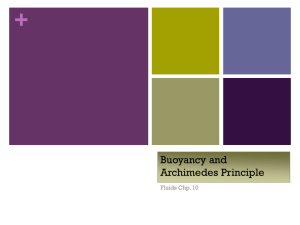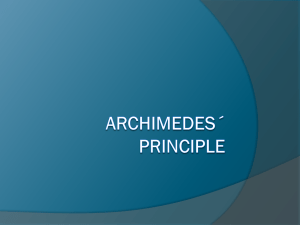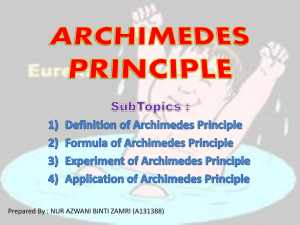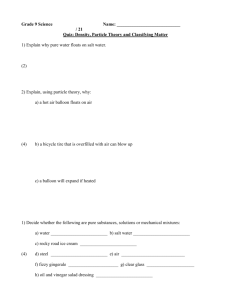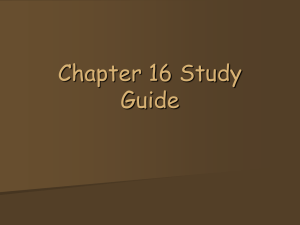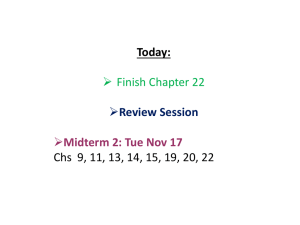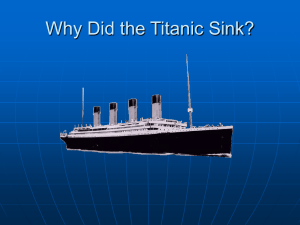Buoyancy and Archimedes’ Principle Assume block is in equilibrium.
advertisement
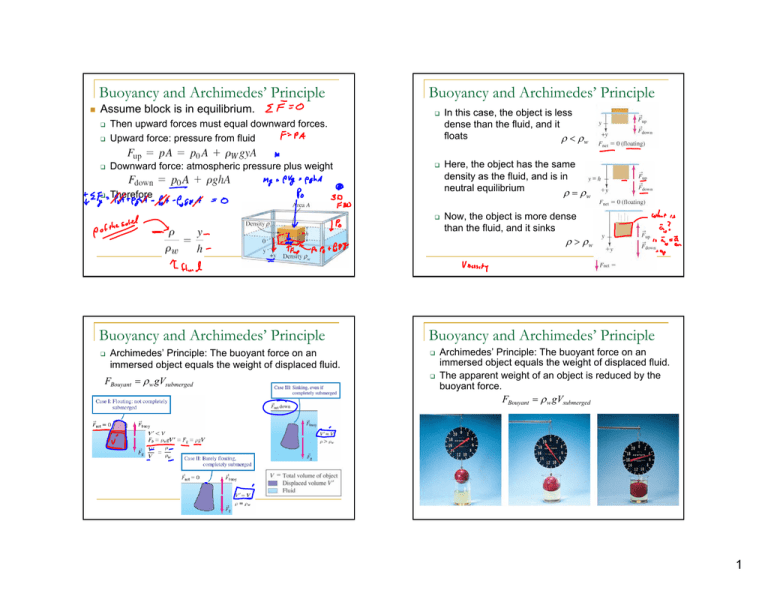
Buoyancy and Archimedes’ Principle Assume block is in equilibrium. Then upward forces must equal downward forces. Upward force: pressure from fluid Downward force: atmospheric pressure plus weight Therefore Buoyancy and Archimedes’ Principle In this case, the object is less dense than the fluid, and it floats ρ < ρw Here, the object has the same density as the fluid, and is in neutral equilibrium ρ=ρ Buoyancy and Archimedes’ Principle Archimedes’ Principle: The buoyant force on an immersed object equals the weight of displaced fluid. FBouyant = ρ w gVsubmerged w Now, the object is more dense than the fluid, and it sinks ρ > ρw Buoyancy and Archimedes’ Principle Archimedes’ Principle: The buoyant force on an immersed object equals the weight of displaced fluid. The apparent weight of an object is reduced by the buoyant force. FBouyant = ρ w gVsubmerged 1 A rectangular tub made of a thin shell of concrete has length l = 1.0 m, width w = 80 cm, depth d = 60 cm, and mass mT = 200 kg. The empty tub floats in a lake. How many students of ms = 80 kg each can stand in the tub before it sinks? A metal sphere weights 29.4 N in air and 18.5 N in water. What is its density? Stability When a body floats it is because the downward force of gravity just cancels the upward force of buoyancy. This alone is not enough; one also wants to know if the floating is stable, that is, whether the floating object might tip over. This can analyzed (and considered in the design) using the laws of mechanics. Stability In thinking about whether, say, a tilting boat will right itself, it is important to note that gravity acts as a single downward force passing through the center of mass of the body while the buoyancy acts as a single upward force passing through the center of mass of the displaced fluid Stability is determined by the Torque (moment) caused by these two forces Stabilizing torque Pushes boat back to an upright position Tipping torque Pushes boat away from the upright position More Slides to Follow 2 ConcepTest 16.9 Two Bricks Imagine holding two identical bricks in place under water. Brick 1 is just beneath the surface of the water, while brick 2 is held about 2 feet down. The force needed to hold brick 2 in place is: ConcepTest 16.11 2) the same 3) smaller The force needed to hold the brick in place underwater is: W – FB. According 1 the weight of the fluid displaced. Since 2 each brick displaces the same amount of fluid, then FB is the same in both cases. ConcepTest 16.12a An object floats in water with 3/4 of its volume submerged. What is the ratio of the density of the object to that of water? Vobject ConcepTest 16.12b 1) 1/4 2) 1/3 3) 4/3 4) 3/4 = ρ object ρ fluid so if the ratio of the volume of the displaced water to the volume of the object is 3/4, 3/4 the object has 3/4 the density of water. water 2) drops 3) remains the same 4) depends on the size of the steel Initially the chunk of steel “floats” by sitting in the boat. The buoyant force is equal to the weight of the steel, and this will require a lot of displaced water to equal the weight of the steel. When thrown overboard, the steel sinks and only displaces its volume in water. water This is not so much water -- certainly less than before -- and so the water level in the lake will drop. The object is now placed in oil with a density half that of water. What happens? Archimedes II 1) it floats just as before 2) it floats higher in the water 3) it floats lower in the water 4) it sinks to the bottom 5) 2/1 Remember that we have: V fluid Archimedes I 1) rises A boat carrying a large chunk of steel is floating on a lake. The chunk is then thrown overboard and sinks. What happens to the water level in the lake (with respect to the shore)? 1) greater to Archimedes’ Principle, FB is equal to On Golden Pond We know from before that the object has 3/4 the density of water. water If the water is now replaced with oil, which has 1/2 the density of water, water the density of the object is larger than the density of the oil. oil Therefore, it must sink to the bottom. 3 ConcepTest 16.12c Archimedes III An object floats in water with 3/4 1) move up slightly of its volume submerged. When 2) stay at the same place more water is poured on top of 3) move down slightly the water, the object will: 4) sink to the bottom 5) float to the top We already know that density of the object is 3/4 of the density of water, water so it floats in water (i.e., the buoyant force is greater than its weight). When covered by more water, it must therefore float to the top. ConcepTest 16.13a Helium Balloon I 1) it still floats at the top because it has positive A helium balloon in buoyancy an air-filled glass jar 2) it stays in the middle because it has neutral floats to the top. If buoyancy the air is replaced 3) it sinks to the bottom because it has negative buoyancy with helium, what will happen to the helium 4) the balloon shrinks in size due to the surrounding helium balloon? 5) the balloon grows in size due to the lack of surrounding air The balloon floats initially because the displaced air weighs more than the balloon, so the buoyant force provides a net upward force. When the balloon is in the lighter helium gas (instead of air), the displaced helium gas does not provide enough of an upward buoyant force to support the weight of the balloon. ConcepTest 16.12d Archimedes IV An object floats in water with 1) move up slightly 3/4 of its volume submerged. 2) stay at the same place When oil is poured on top of 3) move down slightly the water, the object will: 4) sink to the bottom 5) float to the top With the oil on top of the water, there is an additional buoyant force on the object equal to the weight of the displaced oil. The effect of this extra force is to move the object upwards slightly, although it is not enough to make the object float up to the top. ConcepTest 16.13b Now the jar is lifted off the table, but the jar remains inverted to keep the helium gas in the jar. What will happen to the balloon? Helium Balloon II 1) it floats at the top of the jar 2) it floats at the bottom of the jar, but still fully inside the jar 3) it floats below the bottom of the jar, sticking halfway out the bottom 4) it sinks down to the surface of the table The balloon sinks in the helium gas (fluid #1), until it hits the surface of the air (fluid #2). Since the balloon floats in air, it will float on the surface of the air, and therefore remain inside the jar, but at the bottom. 4 ConcepTest 16.14a Wood in Water I ConcepTest 16.14b Wood in Water II Two beakers are filled to the brim with water. A wooden A block of wood floats in a container of block is placed in the second beaker so it floats. (Some of water as shown on the right. On the the water will overflow the beaker). Both beakers are then Moon, how would the same block of wood weighed. Which scale reads a larger weight? float in the container of water? The block in B displaces an amount of A floating object displaces a water equal to its weight, weight since it is weight of water equal to the floating. That means that the weight object’ object’s weight. weight On the Moon, of the overflowed water is equal to the the wooden block has less weight of the block, block and so the beaker weight, weight but the water itself also in B has the same weight as that in A. A same for both Earth Moon has less weight. weight 5
